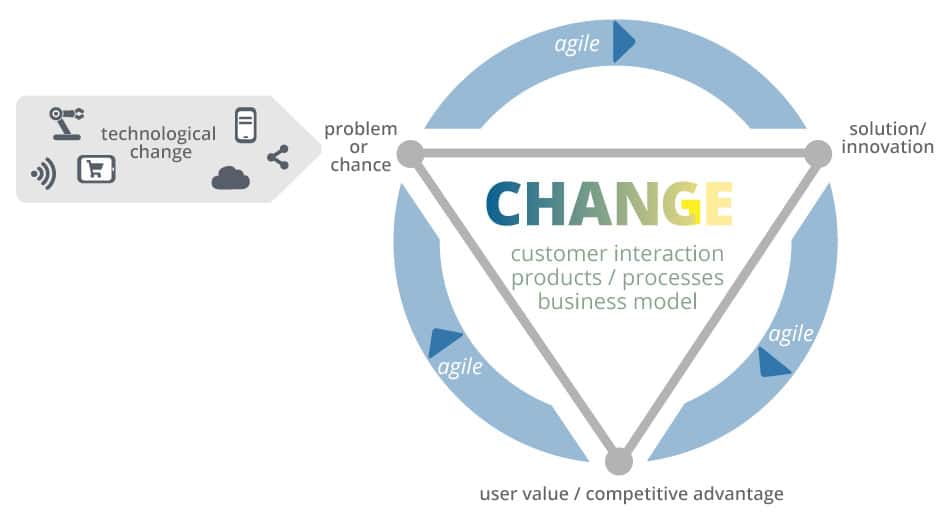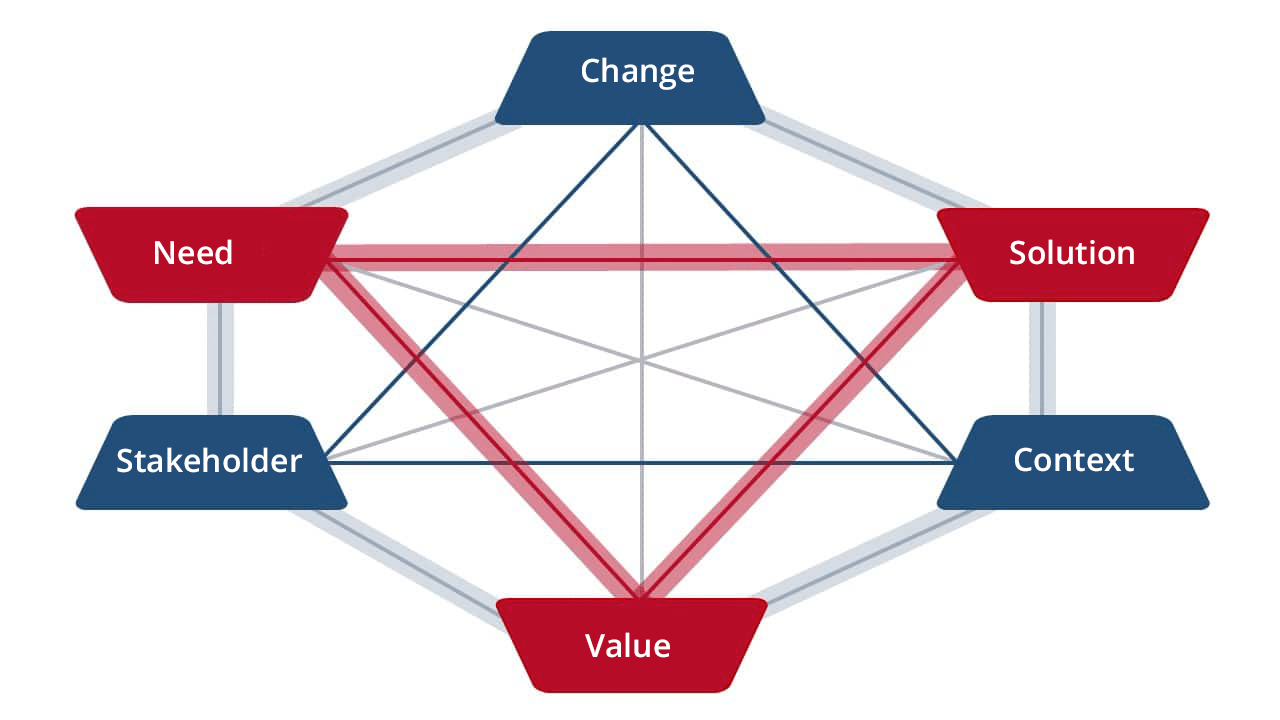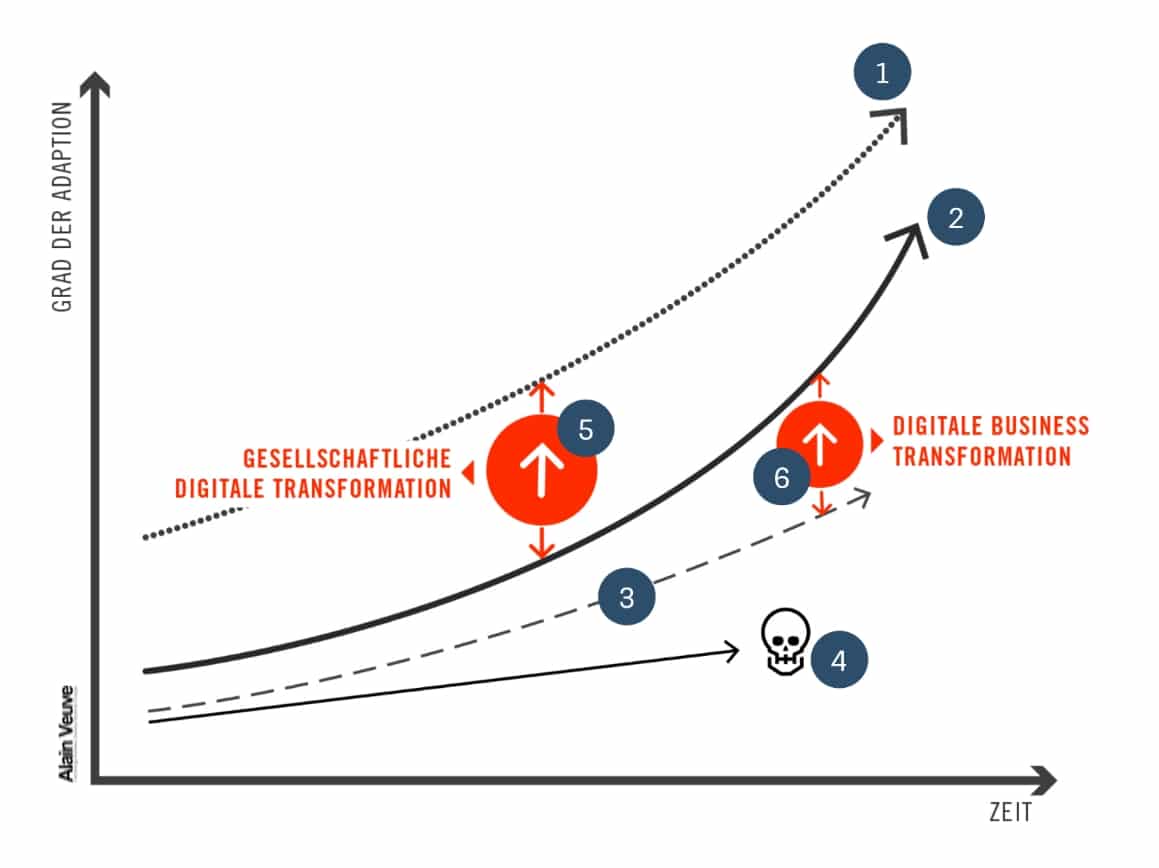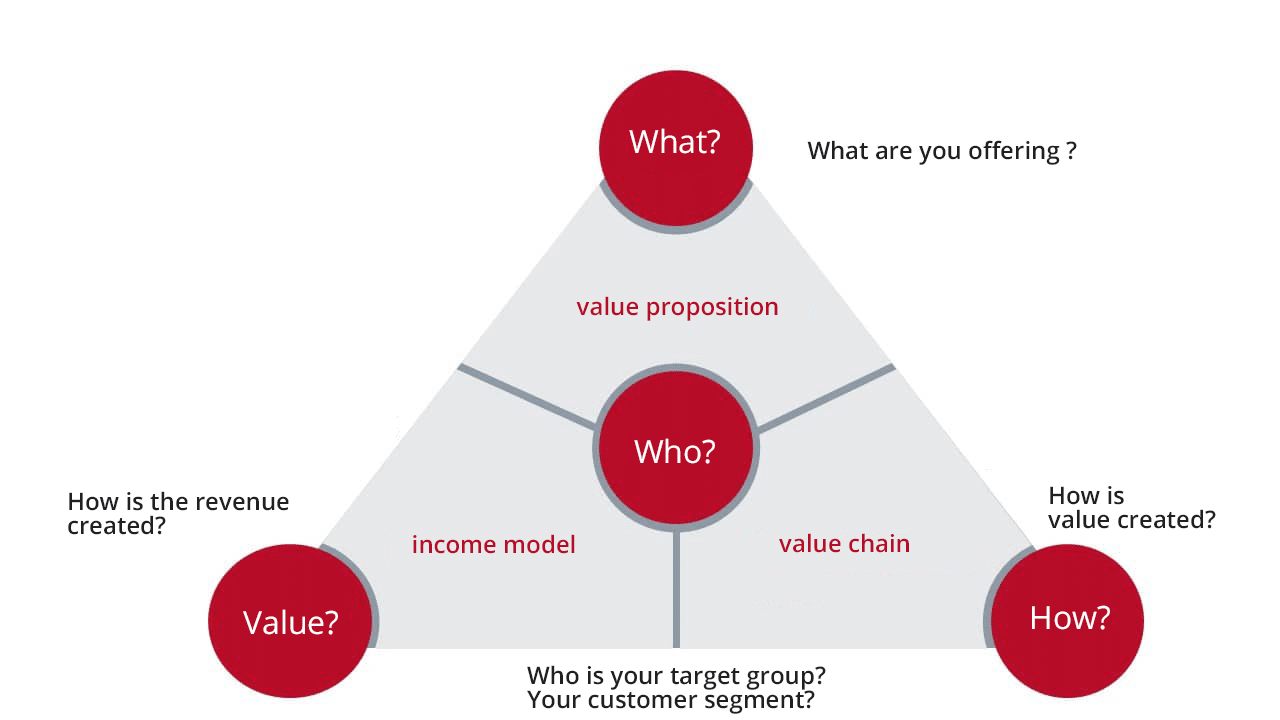Digital Transformation. Through Change That Leads from Need to Value.
How is digital transformation accomplished?

The starting point for strategic analyses is determining need. This can be a problem or an opportunity that arises from technological change.
If the need becomes known, a solution can be developed accordingly. Innovations deliver solutions to problems that stakeholders may not even be aware of. Because technology rapidly changes, agile development is the only choice.
A solution only delivers value when it brings a new benefit. In order for providers to sustain the resulting competitive advantage, change must become a continual process into the future.
Definition:
Digital transformation is a change process, set in motion by digital technologies, which effects an entire society.
Digital transformation refers to an ongoing process of change triggered by digital technologies and affecting companies, individuals and communities, science and politics. Companies, in particular, can benefit from this change by realigning their business models. This is then referred to as digital business transformation. Digitalization is made possible by technologies, so-called enablers. These include infrastructures (e.g. cloud computing, block chain, mobile internet and end devices), applications (e.g. mobile apps) and the resulting business potential:
Extensive use of sensors and devices
Speech and face recognition, embedded technologies, IIoT, robotics, autonomous driving
Use of mobile electronic communication technologies for networking and automated communication
Social networks, crowdsourcing and digital marketing
Gathering, archiving and processing of very large amounts of data
Big data, data mining, business intelligence, artificial intelligence, 3D printing
Machine learning technologies
Machine learning, virtual reality, artificial intelligence
Sophisticated human-computer interaction
Smart living, automation, augmented reality, IoT
The combination of these and other technologies creates a variety of new digital business models and digital value-creating networks. The decisive factor for the selection and use of digital technologies for further or new development of a business model is what benefits will be created for users through the change.
Accenture Studie “Digital Factory: Cracking the code to success” (2016):
75% of the obstacles that confront companies in digital transformation are not of a technical nature.
Three Building Blocks and Three Dimensions of Digital Transformation
The 2011 study “Digital Transformation: Road Map for Billion-Dollar Organizations” identifies three building blocks of digital transformation:
Customer Experience
Mobile forms of interaction with customers for better services, better usability and more precise customer analysis.
Processes
Digitalized business processes to reduce costs & increase efficiency.
Business Models
Digital business models delivering new forms of value for customers.
Prof. Dr. Key Pousttchi describes the impact of digital transformation on companies in three dimensions:
Customer Experience Interaction Model
This encompasses the influence on the types and substance of customer interaction. Key characteristics are the cross-channel and holistic design of the customer relationship and the inclusion of automated communication and modern forms of data analysis.
Value Proposition Model
This encompasses influences on the company’s products, services and revenue models. It requires a process-oriented transformation of the company so that digital technologies will lead to improvements in all corners of the “magic triangle” costs-time-quality.
Value Creation Model
This encompasses influences on the creation of products and services, including the needed support processes and the way the company is structured.
All three building blocks require a foundation in the form of digital skills. These include unified data and processes, analytical skills, business and IT integration and solution delivery. According to the study, digital transformation only works if management provides both the initiative and a compelling vision (top down). In the design more emphasis needs to be placed on the “how” rather than the on the “what.”
It’s especially challenging for large companies to find a new orientation for providing services. A process-oriented, holistic reorganization is required with the goal of increasing productivity in terms of costs-time-quality (the magic triangle). To take on this task, the appointment of a Chief Digital Officer (CDO) is becoming increasingly common. This person is responsible for the operational impelementation of the digitalization strategy at the C-level.
Support for Digital Transformation with objectiF RPM.
Learn more about the enterprise software objectiF RPM »
Digitalization, Digital Transformation und Disruption
These aren’t synonyms, although they’re often mistakenly used as such.
Digitalization
Digitalizing existing processes, products and business models, thus adapting them to modified customer behavior caused by prevailing technologies. There is no way around this if you want to stay in the market.
Digital Transformation
Using new technologies to generate or support new business models. The transformation is prompted by a change in customer behavior. These behavioral changes lead to different or new needs, which are usually no longer satisfied by the company’s current value proposition. Accordingly, the company has to change itself or what it offers.
Disruption
Instead of an evolution in what already exists, a paradigm shift in the form of a completely new business model takes place for solving customer problems. “Disruption” is competitively advantageous for the disrupters of the existing business models. Disruptive innovation succeeds in start-ups because established companies have a hard time changing their business models from the ground up.
Adaptation to technological change and new customer behavior will always be necessary. The cycle creating demand for transformation will likely continue to speed up. The inventor of the Digital Transformation Model, Alain Veuve, proposes “perpetual disruption” as a new term for change. “Perpetual” makes it clear that the change process never stops. “Disruption” describes a radical, profound dimension. This is the defining feature of future business challenges.
What Is a Business Model Innovation?
Oliver Gassmann, Professor of Technology Management at the University of St. Gallen, found that over 90 percent of all innovation in business models involves recombinations, refinements or adaptations of 55 existing business model patterns. This means that only about 10 percent of business model innovations examined were really new (e.g. freemium, long tail or hidden revenue). Companies often succeed in innovating by creatively imitating business models from other industries. Gassmann summarized all the models from the study in the St. Gallen Business Model Navigator.
A business model answers four questions from the Navigator. An innovation in a business model modifies at least two of these four dimensions.
Gassmann recommends four steps for the realignment of a business model:
- Initiation (answering the questions from the model)
- Ideation (confronting the 55 existing business model patterns and questioning the logic of the industry)
- Integration (checking the consistency of the business model)
- Implementation (planning and development in iterative cycles and collecting qualitative/quantitative data to verify or falsify assumptions)
However, according to Gassmann’s analysis, over 70% of change project fail due to mismanagement. Mistakes can be avoided by following these points:
- Only implement one business model innovation at a time
- Clearly communicate the innovation and its reasoning to everyone
- Don’t focus on short-term indicators
- Top management stands behind the innovation and promote it
- Overcome “not-invented-here syndrom”
How Does IoT Influence Business Models?
THING + IT = FEATURE + DIGITAL SERVICE
The Internet of Things is slowly dissolving the separation between the physical and the digital world. Here the connection between these two worlds is no longer only created by humans, but also by things. This results in hybrid objects, suchas sneakers that measure calorie usage and speed. In addition to their local functions (for example, protecting the feet), objects have digital services (collecting data) that can be used beyond the local situation and often at a low cost. This connection between a physical object and the internet generates value in the form of digital services. Such products are sometimes called Digitally Charged Products. Suppliers of physical goods are being increasingly challenged to develop complete services from their product range.
From a business perspective, smart objects are particularly interesting for digitally capturing additional information about the condition of objects and processes. The precise measurability of business activities enables so-called High Resolution Management. Management tasks such as planning, leadership and controlling are supported by automated data acquisition. As a result, the questions from the business model can be answered even more precisely.
Guidelines for Change
What’s the best way to create change in an organization? Is there a method? Yes. Business Analysis is the process of making change possible for an organization by analyzing and defining needs (problems or opportunities) and recommending beneficial solutions to stakeholers accordingly. Since industry and internet culture are becoming increasingly intertwined in companies, business analysts also play an important mediating role between specialist departments and IT.

The Business Analysis Core Concept Model (BACCM™) depicts the defining concepts of a business model. The interdependencies between the individual elements show how procedures and evaluations of results influence each other. The six core concepts are:
- Change – the act of transformation in response to a need
- Stakeholders – have needs
- Context – circumstances that influence or are influenced by
- Needs – can be a problem or an opportunity for change
- Solution – fulfills need(s) in a context
- Value – for a stakeholder in a context
Business analysts use these six core concepts to check the completeness and quality of their work. Questioning each of the components is important and especially necessary when one of the concepts changes. Each part of this foundation must be stable in order to build up a valid analysis.
Agility as a Driving Force in Digital Transformation
Markets are more dynamic than ever before. VUKA (volatility, uncertainty, complexity, and ambiguity) must also be dealt with in digital transformation projects. Value creation is no longer a linear progression. Circumstances, stakeholders, needs and contexts (for example, interfaces and regulations) change much too quickly. This has an effect on needs and the resulting complex web of requirements. For these reasons, you need to be able to react quickly and flexibly to volatility. Here an agile approach is indispensible. It works with iterations and increments. Minimum Viable Products (MVPs) are created in short cycles and rigorously tested by real and potential users to determine their value and benefits. Today, this is the only way to create real innovation.
But how do you become agile? Follow these insights from veteran agilists:
- Agility implies cultural change throughout the entire organization, not just in individual departments (e.g. development)
- It isn’t enough to adopt the rolls, artifacts and activities of agile methods; the principles and values of agility must be accepted and lived by everyone
- Teamwork in agile teams works best with direct communication; for that reason, teamwork in distributed, multidisciplinary teams is inhibitive for agility
- Agility can’t be introduced merely through software and processes. Agile values must be in play to ensure that such tools are implemented succesfully
- Failure must be understood as a chance. Discarded prototypes serve as a positive impulse for improvement
- There must be willingness to constantly question and learn. Lessons learned are essential – even in succesful projects
- New ideas need a safe space where creative experiments can be made. That’s why many companies separate their digital labs both physically and in relation to the main organization.
- The parts make up the whole. Anything developed on the small scale should contribute to the overall strategy. That also means that everyone needs to be familiar with the overall strategy so they can independently and proactively make a relevant contribution.



